Located in Josefsplatz 1, Papyrusmuseum is one of the museums in Austrian National Library. It is the first museum that I visited in Vienna. Although it is not so big, the knowledge you can gain from here is quite respectable. It was the first time I heard about papyrus and then I could explore what was it used for in ancient times.

Papyrus was the egyptian "paper" from about 3000 B.C. till 1000 A.D. The stem of the papyrus plant (1) was cut in stripes which were then placed in two layers (90 degrees to each other) - sometimes interwoven (2) - they were hammered and pressed and finally polished. Glued together, the sheets formed scrolls (3) that were cut to the size needed. Papyrus is very sensitive to humidity and survived the centuries thrown on the rubbish heaps of ancient cities and villages, burried by dry sand (4). For preservation and storing it is very important to know how and where the pieces were found.

The burial customs of the ptolemaic period (4th – 1st century BC) has preserved many papyri of this time. Decreased persons were put into cartonnage that was made of glued together “waste-papyri” and covered by plaster, that was then painted on in bright colors. These papyri are very important since they can be dated very accurately. Many exciting discoveries were made on papyri from cartonnages. The drawing express religious ideas of their time. Stripes of a leg covering (1), the sons of Horus Amset and Kebenehsuef (2), fragments of a mummy mask (3) and the face (4) give an impression of the size of a mummy cartonnage.
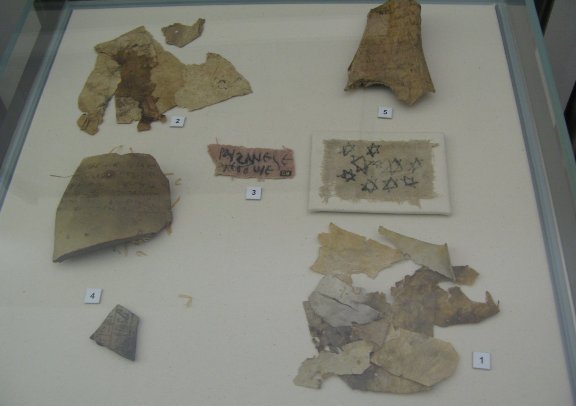
In Egypt almost everything was used to write on, provided it was more or less even. The precious parchment (1) used from the 3rd cent A.D. on, did not replace the papyrus as day to day writing material. Primarily texts which were meant to last long, were written on it. In the 9th century paper (2) was able to replace papyrus, because of its excellent durability. Cloth (3), potsherds (4), limestone splinters, animal bones (5) and wooden tablets were less frequently used. They were nevertheless important for the Eqyptians who wrote very much.
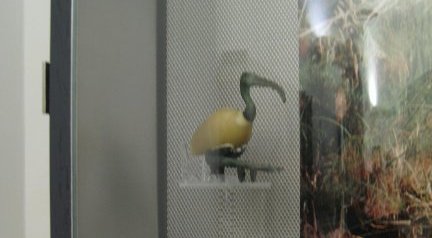
Roots and stem of the papyrus plant give an impression of the origins of papyrus. The egyptian god of writing is Toth symbolized by the Ibis bird (1). In order to write on papyrus a brush (2) or a sharpened reed was empoyed (3). Water, gum arabic and carbon black were used to produce an ink which, when moistened, can still be used today like the ink on the writing tables (4). Written in ink there is a text on a wooden tablet: “Pelilios, son of Horus” (5) a simple mumy lable. A metallic stylus was used to write on wax-tablets (6). And the covers of books were often made of “waste papyrus” (7).

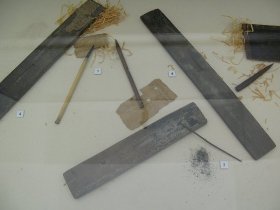
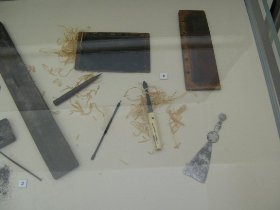
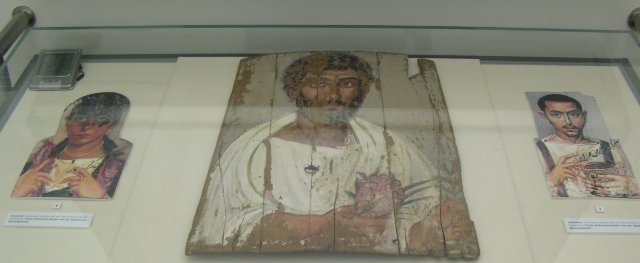
The first mummy-portraits were bought by the artdealer Theodor Graf in 1887. Today there are some 1000 pieces in the different collections all over the world. Only part of the Egyptian population furnished their mummies with pictures. Parallel to this other burial customs were performed. The pictures were bound to the face of the mummy. The earliest pictures are from the time of the emperor Tiberius (14-37 A.D.), the latest date to the 4th century. They were done in the encaustic technique. The colors were bases on wax. Also tempera painting was known. The man on the encaustic portrait holds an ornated cantharus and an olive twig in his hand (3). Clothing and jewelry also reveal information. A woman with a garland made of flowers has rich golden jewelry (4, middle of 2nd cent A.D.). An exceptional piece is the picture in tempera which was put in a frame and fixed on the wall of the grave (9, beginning of 3rd century).

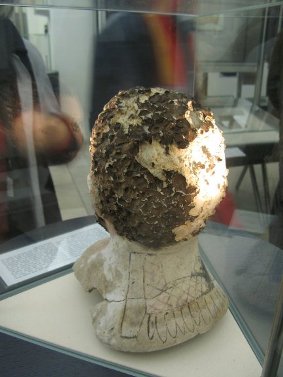
Mummy cartonnage was first made from “waste-papyrus”. Since the time of Augustus there were two kinds in use, one made of linen and the other made of plaster. The head of the mummy on display here is from the necropolis of Tunael-Gebel, the western part of ancient Hermupolis. The head is slightly raised, to indicate the resurrection of the deceased. On the back the deceased is portrayed as a mummy on his funerary bed. The eyes of the mask are made of little pieces of glass, the pupils are painted in black ink (about 200 A.D.)

The head of the mummy is laid down. This indicates an earlier date than that of the mask above where the head is in a higher position. The hair is slighly curled and combed down on the forehead and reminds of the roman emporer Hadrian. The outer part of the eyelid is painted as well as the pupil and the eyebrow. Since there is no beard obviously a young man is depicted (1st quarter of 2nd cent A.D.)

(1) Fish on order: Schinute, a herdsman from Maiuma, orders 20 bottles of cured fish in salt. The name of the fish can probably identified with a kind of catfish that appears in the River Nile.
(2) Fish mummy: This mummy maybe contains a young Nile perch, the holy animal of the godess Neith. Fish was not only used for eating, but also worshipped as a god.
(3) Price list for fruit and fish (6th cent A.D.)
